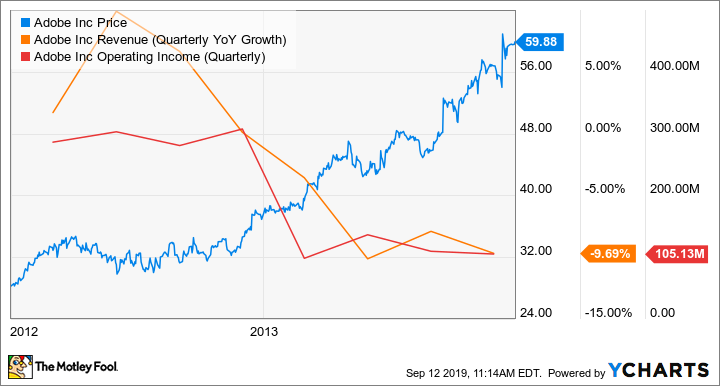It's been a rocky year for Nutanix (NTNX), the cloud software and infrasturcture company.
While a number of SaaS stocks have surged over the past year, Nutanix has mostly been slogging through its transition from a hardware company to a cloud-based software and services provider. The stock surged after the company's recent earnings report topped estimates and it provided better-than-expected guidance for its fiscal first quarter, but the stock is still down more than 50% from its peak in 2018, meaning investors may be asking if there are more gains to be had.
Nutanix may be starting to convince the market of the wisdom of its strategy of moving from hardware and appliance sales to a cloud-based subscription business, but skeptical investors may want to look at recent history in the tech world, as a number of companies have made a similar transition. The best example out of all of them may be Adobe (ADBE -0.77%), the maker of popular programs like Photoshop and Dreamweaver, which transitioned from selling boxed software to cloud-based access to such programs several years ago.
Though the move was challenging at times and Adobe experienced several quarters with declining revenue growth, the decision has clearly paid off. Over the last five years the stock is up nearly 300%, and the company is generating record profits.
Nutanix CEO Dheeraj Pandey sits on the board of Adobe, and sees the software giant as a model for his own company's move to the cloud, telling me that Adobe's experience served as a model for Microsoft, Autodesk and several other companies, and added, "There's a lot to learn from them."

Image source: Getty Images.
How Adobe transitioned
Adobe launched its Creative Cloud in 2012, the subscription-based version of its flagship Creative Suite, which includes well-known applications like Photoshop, Illustrator, and Dreamweaver. However, soon after that launch, its revenue and profits plunged, as the chart below shows.
After the announcement came in April of 2012, revenue growth almost immediately began to fall, and operating income declined by two thirds by the end of that year. That's in part because the adoption of the subscription model tends to delay revenue collection, as it comes in every month rather than in annual lump sum payments when customers by new products.
The following year, in May of 2013, the company doubled down on the strategy, saying it would only make updates to its Creative Cloud product and would not release any new versions of its Creative Suite, the equivalent boxed software sold in stores. As you can see from the chart below, the stock surged through 2013, even though revenue continued to fall and profits remained down. Taking a longer view, the shift has clearly paid off.
Revenue has been growing by 20% or more for several years now, and operating income is up about 150% from where it was before Adobe transitioned to the cloud. Best of all, the stock is up nearly ten times from where it was before the Creative Cloud launch.
What it means for Nutanix
While Adobe, Intuit, and others have proven the wisdom of converting from a physical software model to a cloud-based one, Nutanix faces an additional challenge: The company is transitioning from being a hardware seller to a cloud-based software seller, a move Pandey said that no other company has done before.
As Nutanix's latest report indicates, the company is still in the middle of its transition as revenue declined in the quarter, and Nutanix has not posted a profit as a publicly traded company -- unlike Adobe, which was solidly profitable before, during, and after its transition.
However, Nutanix did show off some promising signs in its latest earnings call. The company said that its backlog had increased by more than 150% from the previous quarter, a sign that its new product offerings are starting to catch on with its customers. Deferred revenue, another representation of its order pipeline, was up 44% from a year ago to $910 million.
It may take a few quarters for the backlog to become visible in other financial metrics like revenue, but those numbers indicate that Nutanix is on the right track. Considering the lofty valuations of many of its SaaS peers and the fact that the stock could double just by returning to its former heights, Nutanix appears to offer considerable upside potential after its latest report showed the beginnings of a turnaround.







